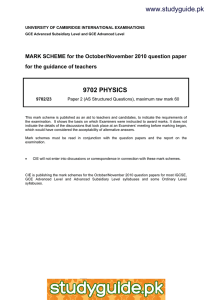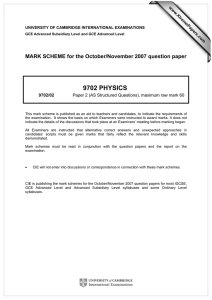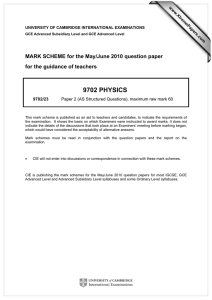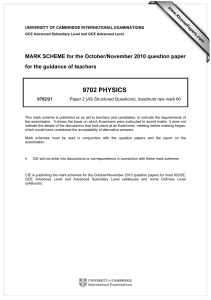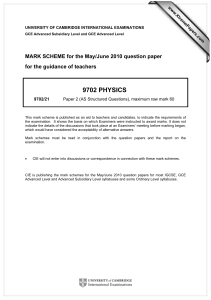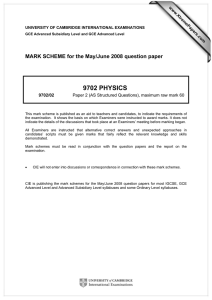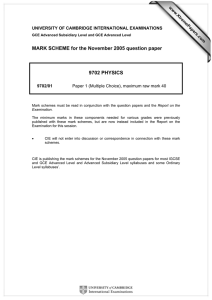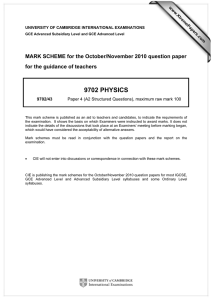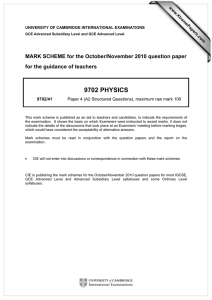9702 PHYSICS MARK SCHEME for the October/November 2010 question paper
advertisement
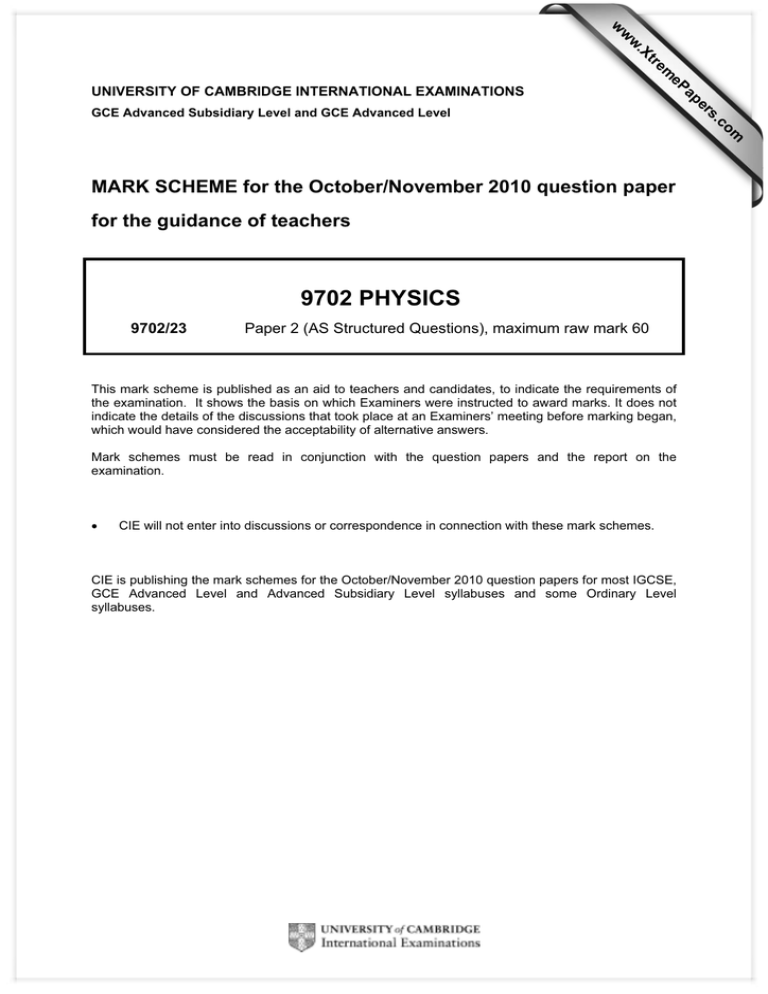
w
w
ap
eP
m
e
tr
.X
w
UNIVERSITY OF CAMBRIDGE INTERNATIONAL EXAMINATIONS
for the guidance of teachers
9702 PHYSICS
9702/23
Paper 2 (AS Structured Questions), maximum raw mark 60
This mark scheme is published as an aid to teachers and candidates, to indicate the requirements of
the examination. It shows the basis on which Examiners were instructed to award marks. It does not
indicate the details of the discussions that took place at an Examiners’ meeting before marking began,
which would have considered the acceptability of alternative answers.
Mark schemes must be read in conjunction with the question papers and the report on the
examination.
•
CIE will not enter into discussions or correspondence in connection with these mark schemes.
CIE is publishing the mark schemes for the October/November 2010 question papers for most IGCSE,
GCE Advanced Level and Advanced Subsidiary Level syllabuses and some Ordinary Level
syllabuses.
om
.c
MARK SCHEME for the October/November 2010 question paper
s
er
GCE Advanced Subsidiary Level and GCE Advanced Level
Page 2
1
Mark Scheme: Teachers’ version
GCE A LEVEL – October/November 2010
Syllabus
9702
Paper
23
(a) allow 0.05 mm → 0.15 mm
B1
[1]
(b) allow 0.25 s → 0.5 s
B1
[1]
(c) allow 8 N → 12 N
B1
[1]
ignore number of significant figures
2
3
crystalline:
atoms / ions / particles in a regular arrangement / lattice
long range order / orderly pattern
(lattice) repeats itself
(1)
polymer:
long chain molecules / chains of monomers
some cross-linking between chains / tangled chains (1)
amorphous: disordered arrangement of molecules / atoms / particles
any ordering is short-range
(1)
(three ‘B’ marks plus any other 2 marks)
B1
B1
B1
B2
[5]
B1
B1
M1
A1
[4]
(a) acceptable straight line drawn (touching every point)
B1
[1]
(b) the distance fallen is not d
d is the distance fallen plus the diameter of the ball
C1
A1
[2]
A1
[1]
C1
C1
A1
[3]
connect microphone / (terminals of) loudspeaker to Y-plates of c.r.o.
adjust c.r.o. to produce steady wave of 1 (or 2) cycles / wavelengths on screen
measure length of cycle / wavelength λ and note time-base b
frequency = 1 / λb
(assume b is measured as s cm–1, unless otherwise stated)
(if statement is ‘measure T, f = 1/T’ then last two marks are lost)
4
(‘d is not measured to the bottom of the ball’ scores 2/2)
(c) (i) diameter: allow 1.5 ± 0.5 cm (accept one SF)
no ecf from (a)
(ii) gradient = 4.76, ± 0.1 with evidence that origin has not been used
gradient = g / 2
g = 9.5 m s–2
© UCLES 2010
Page 3
5
Mark Scheme: Teachers’ version
GCE A LEVEL – October/November 2010
B1
[1]
(ii) Fig. 5.3
B1
[1]
(b) kinetic energy increases from zero then decreases to zero
B1
[1]
(c) (i) ∆EP = mg∆h / mgh
= 94 × 10–3 × 9.8 × 2.6 × 10–2
= 0.024 J
C1
using g = 10 then –1
A1
½ kd 2 = ½k × (2.6 × 10–2)2 – ½kd 2
kd 2 = ½k × (2.6 × 10–2)2
d = 0.018 m
= 1.8 cm
[2]
C1
C1
A1
[3]
(a) when two (or more) waves meet (at a point)
(resultant) displacement is (vector) sum of individual displacements
B1
B1
[2]
(b) (i) λ = ax / D (if no formula given and substitution is incorrect then 0/3)
590 × 10–9 = (1.4 × 10–3 × x) / 2.6
x = 1.1 mm
C1
C1
A1
[3]
A1
[1]
(ii) 1. 180° (allow π if rad stated)
2. at maximum, amplitude is 3.4 units and at minimum, 0.6 units
intensity ~ amplitude2 allow I ~ a2
ratio = 3.42 / 0.62
= 32
7
Paper
23
(a) (i) Fig. 5.2
(ii) either 0.024 = ½ k × (2.6 × 10–2)2 or
0.012 = ½k × d 2
d = 0.018 m
= 1.8 cm
6
Syllabus
9702
C1
C1
A1
[3]
B1
B1
[2]
(ii) 1. (F =) E.g
B1
[1]
2. (t =) L / v
B1
[1]
M1
A1
[2]
B1
[1]
(a) (i) path: reasonable curve upwards between plates
straight and at a tangent to the curve beyond the plates
(b) (i) total momentum of a system remains constant or total momentum of a
system before a collision equals total momentum after collision
provided no external force acts on the system
(do not accept ‘conserved’ but otherwise correct statement gets 1/2)
(ii) (∆p =) EqL / v
(iii) either
or
allow ecf from (a)(ii)
charged particle is not an isolated system
so law does not apply
system is particle and ‘plates’
equal and opposite ∆p on plates / so law applies
© UCLES 2010
M1
A1 [2]
(M1)
(A1)
Page 4
8
Mark Scheme: Teachers’ version
GCE A LEVEL – October/November 2010
(a) (i) either P = V 2 / R
R = 2302 / 1200
= 44.1 Ω
9
or
or
Syllabus
9702
I = 1200 / 230 or 5.22
R = (230 × 230) / 1200
R = 230 / 5.22
= 44.1 Ω
Paper
23
C1
M1
A0
[2]
(ii) R = ρL / A
= (1.7 × 10–8 × 9.2 × 2) / (π × {0.45 × 10–3}2)
= 0.492 Ω
C1
M1
A0
[2]
(b) current = 230 /44.6
power = (230 /44.6)2 × 44.1
= 1170 W
(allow full credit for solution based on potential divider)
C1
C1
A1
[3]
(c) e.g. less power dissipated in the heater / smaller p.d. across heater /
more power loss in cable / current lower
cable becomes heated / melts
(any two sensible suggestions, 1 each, max 2)
B1
B1
[2]
(a) nucleus emits α-particles or β-particles and/or γ-radiation
to form a different / more stable nucleus
B1
B1
[2]
(b) (i) fluctuations in count rate (not ‘count rate is not constant’)
B1
[1]
(ii) no effect
B1
[1]
(iii) if the source is an α-emitter
either α-particles stopped within source (and gain electrons)
or
α-particles are helium nuclei
B1
allow 1/2 for ‘parent nucleus gives off radiation to form daughter nucleus’
© UCLES 2010
B1
[2]
